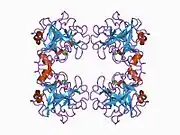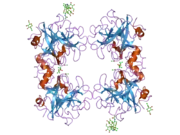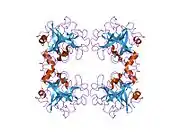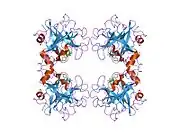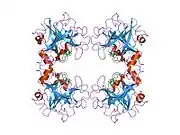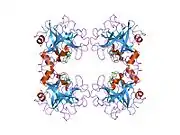| TPSAB1 | |||||||||||||||||||||||||||||||||||||||||||||||||||
|---|---|---|---|---|---|---|---|---|---|---|---|---|---|---|---|---|---|---|---|---|---|---|---|---|---|---|---|---|---|---|---|---|---|---|---|---|---|---|---|---|---|---|---|---|---|---|---|---|---|---|---|
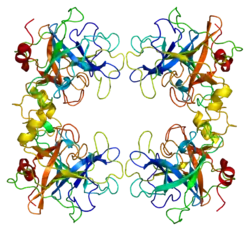 | |||||||||||||||||||||||||||||||||||||||||||||||||||
| |||||||||||||||||||||||||||||||||||||||||||||||||||
| Identifiers | |||||||||||||||||||||||||||||||||||||||||||||||||||
| Aliases | TPSAB1, TPS1, TPS2, TPSB1, tryptase alpha/beta 1, TPSB2, Tryptase-2 | ||||||||||||||||||||||||||||||||||||||||||||||||||
| External IDs | OMIM: 191080 MGI: 96942 HomoloGene: 55729 GeneCards: TPSAB1 | ||||||||||||||||||||||||||||||||||||||||||||||||||
| |||||||||||||||||||||||||||||||||||||||||||||||||||
| |||||||||||||||||||||||||||||||||||||||||||||||||||
| |||||||||||||||||||||||||||||||||||||||||||||||||||
| |||||||||||||||||||||||||||||||||||||||||||||||||||
| |||||||||||||||||||||||||||||||||||||||||||||||||||
| Wikidata | |||||||||||||||||||||||||||||||||||||||||||||||||||
| |||||||||||||||||||||||||||||||||||||||||||||||||||
Tryptase alpha-1 and tryptase beta-1 are enzymes that in humans are encoded by the same TPSAB1 gene.[5][6] Beta tryptases appear to be the main isoenzymes expressed in mast cells; whereas in basophils, alpha tryptases predominate.[7]
Function
Tryptases comprise a family of trypsin-like serine proteases, the peptidase family S1. Tryptases are enzymatically active only as heparin-stabilized tetramers, and they are resistant to all known endogenous proteinase inhibitors. Several tryptase genes are clustered on chromosome 16p13.3. These genes are characterized by several distinct features. They have a highly conserved 3' UTR and contain tandem repeat sequences at the 5' flank and 3' UTR which are thought to play a role in regulation of the mRNA stability. These genes have an intron immediately upstream of the initiator Met codon, which separates the site of transcription initiation from protein coding sequence. This feature is characteristic of tryptases but is unusual in other genes. The alleles of this gene exhibit an unusual amount of sequence variation, such that the alleles were once thought to represent two separate genes, alpha and beta 1.Tryptases have been implicated as mediators in the pathogenesis of asthma and other allergic and inflammatory disorders.[7]
References
- 1 2 3 GRCh38: Ensembl release 89: ENSG00000172236 - Ensembl, May 2017
- 1 2 3 GRCm38: Ensembl release 89: ENSMUSG00000033825 - Ensembl, May 2017
- ↑ "Human PubMed Reference:". National Center for Biotechnology Information, U.S. National Library of Medicine.
- ↑ "Mouse PubMed Reference:". National Center for Biotechnology Information, U.S. National Library of Medicine.
- ↑ Miller JS, Moxley G, Schwartz LB (Oct 1990). "Cloning and characterization of a second complementary DNA for human tryptase". J Clin Invest. 86 (3): 864–70. doi:10.1172/JCI114786. PMC 296804. PMID 2203827.
- ↑ Pallaoro M, Fejzo MS, Shayesteh L, Blount JL, Caughey GH (Feb 1999). "Characterization of genes encoding known and novel human mast cell tryptases on chromosome 16p13.3". J Biol Chem. 274 (6): 3355–62. doi:10.1074/jbc.274.6.3355. PMID 9920877.
- 1 2 "Entrez Gene: TPSAB1 tryptase alpha/beta 1".
Further reading
- Sommerhoff CP, Bode W, Matschiner G, et al. (2000). "The human mast cell tryptase tetramer: a fascinating riddle solved by structure". Biochim. Biophys. Acta. 1477 (1–2): 75–89. doi:10.1016/s0167-4838(99)00265-4. PMID 10708850.
- Kam CM, Hudig D, Powers JC (2000). "Granzymes (lymphocyte serine proteases): characterization with natural and synthetic substrates and inhibitors". Biochim. Biophys. Acta. 1477 (1–2): 307–23. doi:10.1016/s0167-4838(99)00282-4. PMID 10708866.
- Caughey GH (2003). "New developments in the genetics and activation of mast cell proteases". Mol. Immunol. 38 (16–18): 1353–7. doi:10.1016/S0161-5890(02)00087-1. PMID 12217407.
- Vanderslice P, Ballinger SM, Tam EK, et al. (1990). "Human mast cell tryptase: multiple cDNAs and genes reveal a multigene serine protease family". Proc. Natl. Acad. Sci. U.S.A. 87 (10): 3811–5. Bibcode:1990PNAS...87.3811V. doi:10.1073/pnas.87.10.3811. PMC 53993. PMID 2187193.
- Miller JS, Westin EH, Schwartz LB (1989). "Cloning and characterization of complementary DNA for human tryptase". J. Clin. Invest. 84 (4): 1188–95. doi:10.1172/JCI114284. PMC 329777. PMID 2677049.
- Schwartz LB, Bradford TR, Littman BH, Wintroub BU (1985). "The fibrinogenolytic activity of purified tryptase from human lung mast cells". J. Immunol. 135 (4): 2762–7. doi:10.4049/jimmunol.135.4.2762. PMID 3161948.
- Schwartz LB, Lewis RA, Seldin D, Austen KF (1981). "Acid hydrolases and tryptase from secretory granules of dispersed human lung mast cells". J. Immunol. 126 (4): 1290–4. doi:10.4049/jimmunol.126.4.1290. PMID 7009736.
- Xia HZ, Kepley CL, Sakai K, et al. (1995). "Quantitation of tryptase, chymase, Fc epsilon RI alpha, and Fc epsilon RI gamma mRNAs in human mast cells and basophils by competitive reverse transcription-polymerase chain reaction". J. Immunol. 154 (10): 5472–80. doi:10.4049/jimmunol.154.10.5472. PMID 7730649.
- Blom T, Hellman L (1993). "Characterization of a tryptase mRNA expressed in the human basophil cell line KU812". Scand. J. Immunol. 37 (2): 203–8. doi:10.1111/j.1365-3083.1993.tb01757.x. PMID 8434231. S2CID 22041090.
- Cairns JA, Walls AF (1996). "Mast cell tryptase is a mitogen for epithelial cells. Stimulation of IL-8 production and intercellular adhesion molecule-1 expression". J. Immunol. 156 (1): 275–83. doi:10.4049/jimmunol.156.1.275. PMID 8598474.
- Schwartz LB, Sakai K, Bradford TR, et al. (1996). "The alpha form of human tryptase is the predominant type present in blood at baseline in normal subjects and is elevated in those with systemic mastocytosis". J. Clin. Invest. 96 (6): 2702–10. doi:10.1172/JCI118337. PMC 185977. PMID 8675637.
- Cairns JA, Walls AF (1997). "Mast cell tryptase stimulates the synthesis of type I collagen in human lung fibroblasts". J. Clin. Invest. 99 (6): 1313–21. doi:10.1172/JCI119290. PMC 507947. PMID 9077541.
- Xia HZ, Du Z, Craig S, et al. (1997). "Effect of recombinant human IL-4 on tryptase, chymase, and Fc epsilon receptor type I expression in recombinant human stem cell factor-dependent fetal liver-derived human mast cells". J. Immunol. 159 (6): 2911–21. doi:10.4049/jimmunol.159.6.2911. PMID 9300715. S2CID 45026410.
- Thomas VA, Wheeless CJ, Stack MS, Johnson DA (1998). "Human mast cell tryptase fibrinogenolysis: kinetics, anticoagulation mechanism, and cell adhesion disruption". Biochemistry. 37 (8): 2291–8. doi:10.1021/bi972119z. PMID 9485375.
- Pereira PJ, Bergner A, Macedo-Ribeiro S, et al. (1998). "Human beta-tryptase is a ring-like tetramer with active sites facing a central pore". Nature. 392 (6673): 306–11. Bibcode:1998Natur.392..306P. doi:10.1038/32703. PMID 9521329. S2CID 4421972.
- Huang C, Li L, Krilis SA, et al. (1999). "Human tryptases alpha and beta/II are functionally distinct due, in part, to a single amino acid difference in one of the surface loops that forms the substrate-binding cleft". J. Biol. Chem. 274 (28): 19670–6. doi:10.1074/jbc.274.28.19670. PMID 10391906.
- Sommerhoff CP, Bode W, Pereira PJ, et al. (1999). "The structure of the human betaII-tryptase tetramer: fo(u)r better or worse". Proc. Natl. Acad. Sci. U.S.A. 96 (20): 10984–91. Bibcode:1999PNAS...9610984S. doi:10.1073/pnas.96.20.10984. PMC 34230. PMID 10500112.
- Romagnani P, De Paulis A, Beltrame C, et al. (1999). "Tryptase-chymase double-positive human mast cells express the eotaxin receptor CCR3 and are attracted by CCR3-binding chemokines". Am. J. Pathol. 155 (4): 1195–204. doi:10.1016/S0002-9440(10)65222-4. PMC 1867029. PMID 10514402.







